Have you noticed? Many local professional theaters are batting around the word "immersive." Immersive musicals, immersive solo shows, but with Miami New Drama's "The Museum Plays," director and conceptualizer Michel Haussman comes through with a truly immersive experience.
He commissioned six playwrights: Hanna Benitez, Harley Elias, Rogelio Martinez, Carmen Pelaez, Marco Ramirez, and Aurin Squire. Selecting art at Miami’s Rubell Museum in the Allapattah neighborhood, the writers were tasked with building short plays around particular pieces of art in the robust contemporary collection – works by Alfonso Gonzalez, Jr., Jenna Gribbon, Glenn Ligon, Kaari Upson, and Kehinde Wiley.
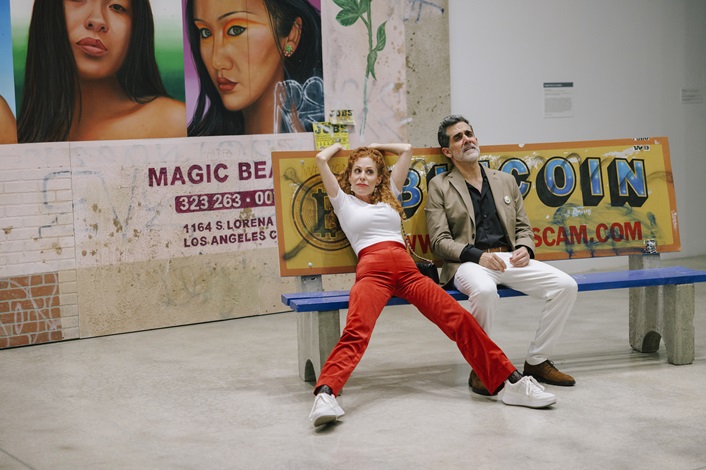
Marjery Lowe in costumer Olatz Zanguitu and Saul Mendoza's bright red pants against Los Angeles painter Alfonso Gonzalez Jr.'s "Your Ad Here" In Harley Elias's “Pump and Dump.” (Photo by James Jackman)
In addition to seeing original theater, it's also a chance to get up close to great art in a gem of a museum right here in our backyard. (You will want to return to the Rubell Museum after seeing this show.)
The idea creative, the experience an out-of-the-box, site specific draw away from the usual proscenium stage production, the coordination complicated: moving five different groups of 30 audience members throughout the museum into different spaces at the same time. (All went seamlessly on opening night.)
Haussman conjured a similar experience during COVID when theaters were shut down. Nine months in, he invited theater starved (entertainment starved, for that matter) audiences outside, commissioned 10-minute plays from seven playwrights and put the collection, entitled "Seven Deadly Sins," in empty storefronts along a block of Lincoln Road. The logistics were similar.
The experience for "The Museum Plays" starts this way. Check in at the Rubell and your ticket is now a colored wristband denoting the group you will be in – blue, green, yellow, orange, pink.
Almost like being a tourist led through a museum, your guide holds a flag in the air with the color of your group. Our guide was effervescent, informative, and strict about the rules – don't take videos or pictures of the actors, but taking pictures of the art is fine, meander after each play is over to look at the work, but not too long, and stay with the group. He carried a clipboard and wore an earpiece used to communicate the all clear, i.e. that the prior group has moved on and your group can now enter. How all this happens is theater magic.
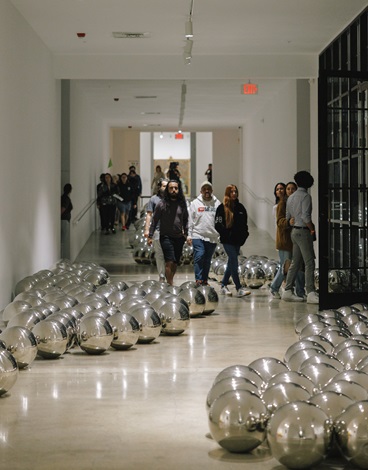
Every group starts by traversing through the museum's central hallway among the colossally fantastic "Narcissus Garden" by Yayoi Kusama. (Photo by James Jackman)
Housed in what used to be an industrial warehouse, the 53,000 square foot museum space is divided into 36 galleries. (The plays take place in the 6, 9, 23, 28, 34 galleries and the library). All of the more than 7,000 pieces inside are an incredible contemporary collection of Don and Mera Rubell, and one of the biggest private collections in the United States.
Every group starts by traversing through the museum's central hallway among the colossally fantastic "Narcissus Garden" by Yayoi Kusama, 700 mirrored stainless-steel spheres flowing over 200 feet. Tip: Don't just walk by this work, take it in. (If you want to see more of Kusama, "Love is Calling" is on view not too far from here at the Perez Art Museum Miami)
Then, depending on which group you are in, you're led to see the first 10-minute play.
One or both of the actors (these are all two-person plays, except for the finale) are already in place when the group enters. Take your seat on long rows of benches in some galleries or chairs in other settings.
Some of the plays fare better than others, but all of them are light making the night at the theater an adventurous and accessible experience.
(While the line ups are different, here is the order in which the plays followed suit for the opening night's blue group.)
A museum doucet (Timothy Mark Davis) is giving a lecture on the female nude's place in art history when he is interrupted by a gallery gazer (Kelly Pekar) who refuses to leave in Hanna Benitez's "Mousa." Turns out the Woman has a stake in the game. When the Doucet runs off to get security to usher her out, she takes over and begins telling the attendees what the life of a muse is like. Using the Doucet's slide presentation, the reveal is that she has been the model for almost every famous naked female through the ages, even an unrecognizable female figure pioneered by Pablo Picasso.
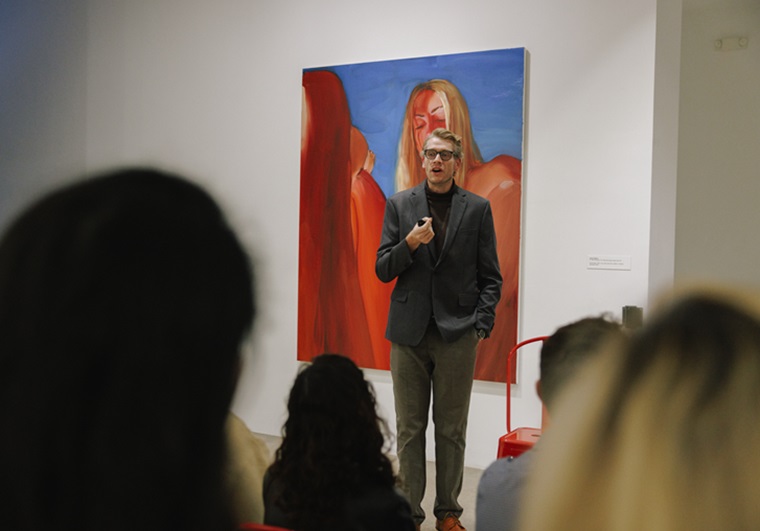
Timothy Mark Davis is the Doucet in Hanna Benitez's "Mousa," one of Miami New Drama's "Museum Plays" at the Rubell Museum. (Photo by James Jackman)
"A muse cannot escape until they capture her." Benitez has a feminist message since every one of the female forms in the Doucet's slide presentation are flawless figures. But the Woman fixed her gaze from the start on one painting hanging on the gallery wall.
Jenna Gribbon’s “Scenicscape.” (2021) is a large oil on linen of a nude blonde (Gribbon uses as her muse her lover Mackenzie Scott as her main subject). The body, bright pink against a blue background, is a realistic depiction. Folds in the subject's stomach and somewhat drooping breasts give the muse pleasure: "The harmony of the flaw," the Woman says.
Benitez has a strong premise but undercuts it by giving into cliches as the Doucet becomes flustered at one point when phallic images are accidentally mixed into his very serious high-brow presentation. "Mousa," nonetheless, is exceptional.
Aurin Squire's "Maybe Love" finds a couple on a first date surrounded by the works of Kehinde Wiley, famous for his portrait of former President Barack Obama. Wiley's art places contemporary Black subjects juxtaposed in positions reserved by the Old Masters. Here, we're surrounded by "Sleep" (2008), "Equestrian Portrait of the Count Duke Olivares" (2005), and the triptych "Triple Portrait of Charles I" (2007).
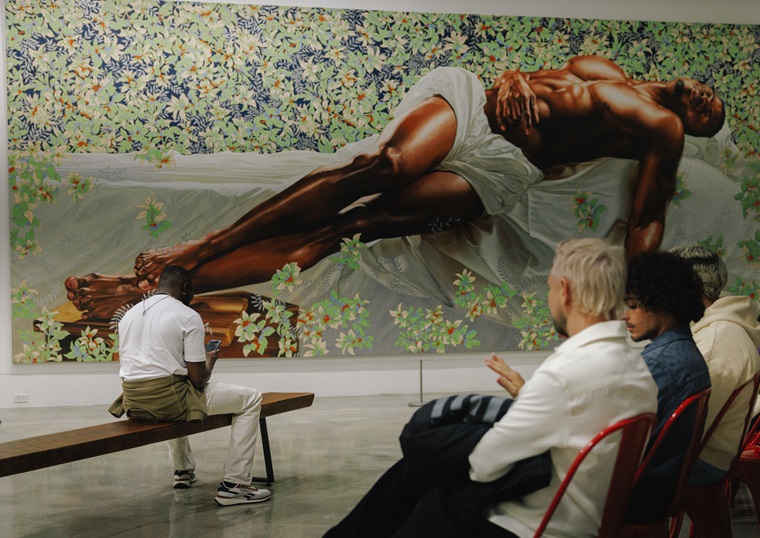
Jovon Jacobs is dwarfed by the triumphant Kehinde Wiley's "Sleep" at the Rubell Museum in Miami New Drama's "The Museum Plays." (Photo by Josh Aronson)
Although he positions his characters going through the typical nerves and paces of meeting on a first date, Squire smartly uses the opportunity to comment on Wiley's art using Regina (Renata Eastlick) as the arbiter. It is difficult not to be distracted by the impressive and massive works in 34 Gallery, especially "Sleep" (2008) an epic painting, which Wiley based on the French artist Jean Bernad Restout's painting of the god of slumber, in an almost Christ-like depiction. Squire jolts us into our sense of place with humor as Terrence (Jovon Jacobs) tries to impress Regina by speaking French. She retorts: "Speaking French in Miami, that's like windsurfing in Idaho."
Squire is a master playwright – it's just this week been announced that his play "A Wonderful World: The Louis Armstrong Musical," which was developed at Miami New Drama" in 2021, will open on Nov. 11, 2024 at Studio 54 in New York.
Marjery Lowe and Carlos Orizondo have their work cut out for them with Harley Elias’s “Pump and Dump," inspired by Los Angeles painter Alfonso Gonzalez Jr.’s “Your Ad Here" (2021), a graffitied bench pitching Bitcoin with the words WWW NOT A SCAM.COM. Lowe plays an in-a-hurry art buyer and Orizondo an art dealer, who also deals in bitcoin. Elias's short play title comes from the pump and dump scheme where the value of a token is artificially inflated to attract buyers but eventually crashes the price.
If you're not familiar with the semantics of this, the short's subject matter is a little difficult to follow, but the frenetic pace of the characters and Elias's dialogue tempo fits right in with the surrounding works in this exhibition space, "Singular Views: Los Angeles." The Rubells have plenty of statement-making L.A. art, so meander around this gallery after the play before you move on.
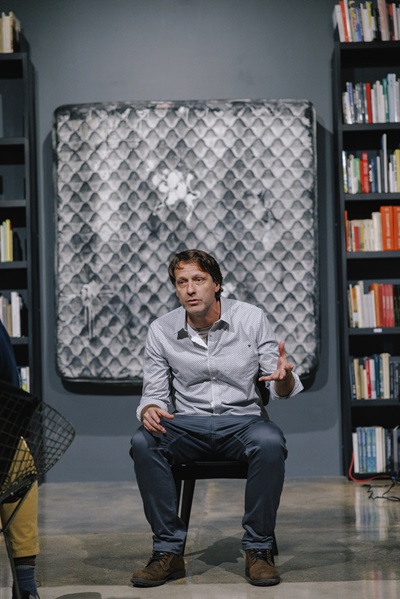
Caleb Scott in Rogelio Martinez's “Bedfellows” inspired by the late Kaari Upson's 2014 work “Rubells.” (Photo by Josh Aronson)
Rogelio Martinez's "Bedfellows," inspired by L.A.'s Karri Upson's "Rubells," (2014), a silicone, spandex and fiberglass mattress, takes place in the museum's art research library among 40,000 volumes, the most extensive in South Florida. Our guide tells the group a bit of trivia about a reclining chair in the library. Do not sit there; the chair is only allowed to be occupied by one person – Don Rubell himself.
Martinez's play deals with mortality using Upson's story as the catalyst. Upson was 51 when she died of cancer in 2021. "I teach playwrighting," says Caleb Scott's character as Martinez. Benitez (who wrote "Mousa" for "The Museum Plays") enters wearing a baseball cap, she's supposed to be Hausmann working with the playwright on the script for "The Museum Plays." The director is demanding a rewrite.
Interspersed with lessons on how to write a play, the machinations of what goes into creating the work, he recalls becoming intrigued with Upson. He had listened to an interview with her.
Benitez enters again, this time as Upson, and sits behind a microphone at a table, the sound in the microphone mimics that of a radio interview – she talks about her art and life as the interview is recreated. It's haunting in the confines of the library – Martinez's intimate play, Scott's command of the character and Upson's mattress, the work commissioned by the Rubells themselves in 2014, purposely tattered and decrepit. The artist referred to her mattress series as "artifacts of disease."
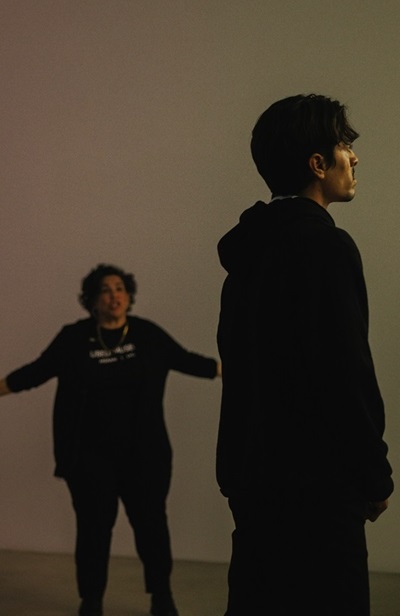
Carmen Pelaez and Carlos Fabian Medina in Pelaez's “Waiting for America,” part of “The Museum Plays” at the Rubell Museum. (Photo by James Jackman)
Carmen Pelaez’s “Waiting for America” is inspired by Glenn Ligon’s neon sign “America." Palaez is a talented playwright and a wonderful actor. The only downside of this play is a difficulty in understanding all of the dialogue between the museum boss, Celeste, and her underling, Darwin (Carlos Fabian Medina), mostly because of the acoustics in a gallery room not conducive to playing the role of a performance space. Perhaps the seating area should be brought in closer for this one.
But listen carefully because it is astonishing how much Pelaez packs into 10 minutes in an immensely relative-to-today depiction of an immigrant feeling out of place in a modern Estados Unidos that doesn't quite live up to the American dream.
Closing out "The Museum Plays," but not tied to a work of art but contemporary art society as a whole, Hialeah native Marco Ramirez's comedic play “Body of Work” gathers all 150 audience members for the funeral of experiential artist Vivian Nameless.
Her lipstick-red casket is center, Pelaez is the eulogizer and the other cast members play funeral goers, all with some connection to Ms. Nameless. The artist has, for her final work of art, decided to auction off her body. The commentary on the sometime absurdity of contemporary art especially in a city that is turned upside during Miami Art Week every year is the perfect surprise ending to close out the evening.
Credit to the scenic consultants, Justin and Christopher Swader, who helped to configure the spaces and Hausmann's astute craft in how people, both actors and audience, would navigate the spaces. His direction had each play stand as a singular experience, which made it even more satisfying to see six. Kudos to Katelyn Bourke stage manager and Alexa Gutierrez, assistant stage manager, for wrangling it all.
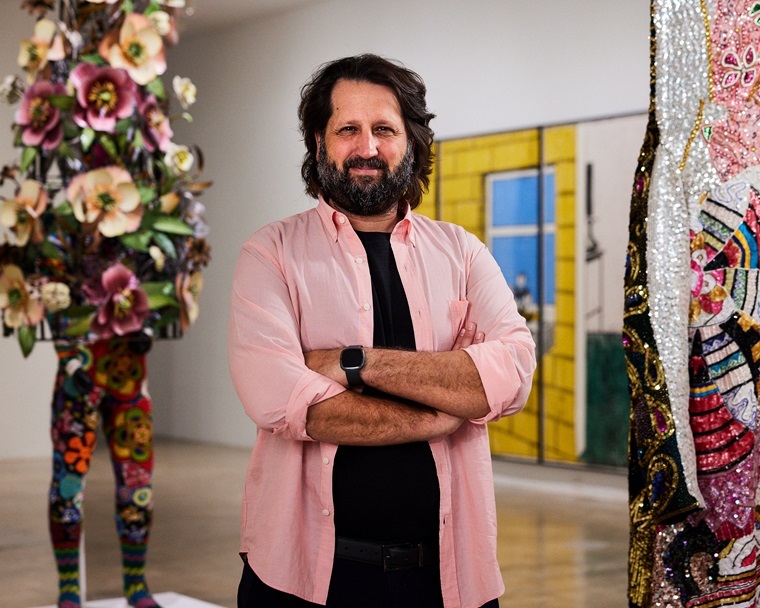
Michel Hausmann, Artistic Director of Miami New Drama, conceived, created and directed "The Museum Plays" at the Rubell Museum. (Photo by FURIOSA productions)
Olatz Zanguitu and Saul Mendoza's contemporary costumes took in the surroundings, sometimes grabbing a color from one of the paintings (Lowe's bright red pants on the graffiti bench are a perfect example). Lighting designer Leo Urbina was up to the task of bringing the plays into focus without casting any harshness onto the artworks.
"The Museum Plays" is a masterpiece in its own right, overflowing with creativity: Hausmann's command of the massive puzzle that needs to fit together to make it all work, the playwrights' understanding and delivering on the nature of the assignments, a strong, engaging cast, and the ability to perform theater in a space that isn't built for it, all mixed together with the Rubells' eagerness to be part of the effort. It is undoubtedly a work of modern art that they can be proud to add to their collection.
Miami New Drama presents “The Museum Plays” at the Rubell Museum galleries, 1100 NW 23rd St., Miami. 8 p.m. Thursday, Friday and Saturday, 7 p.m. Sunday, through March 31. Tickets are $81.50 or $91.50 for premium seating, $45.50 for standing room. Call 305-674-1040 or www.miaminewdrama.org




